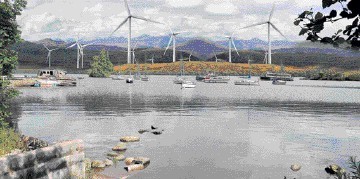
A SCOTTISH mountaineering group says plans to build windfarms in the hills around Loch Ness could have a “devastating” impact on the area.
Local residents and estate owners have also joined the opposition to proposals for three major projects overlooking the Great Glen.
SSE recently lodged plans for two developments – the biggest at Stronelairg, where 83 turbines are proposed on the Monadhliath Mountains, near the Glendoe hydro scheme. Each would stand 443ft tall.
The energy company also plans a windfarm on the other side of the loch, near Invermoriston. The Bhlaraidh development will involve 36 turbines at the same height.
Now, a third development is being considered near Whitebridge, with 20 turbines planned for the Dell Estate. The devices could up to 492ft tall.
Falck Renewables and Coriolis Energy are behind the proposals, which are still at an early stage but have already met with opposition.
The Mountaineering Council of Scotland said it feared the Dell plans would have a “devastating impact” on views from the Cairngorms National Park. And it claimed there would be a “significant cumulative visual impact” when combined with the Stronelairg development, which lies immediate south of the Falck and Coriolis site.
Scottish Natural Heritage has expressed similar views, stating that the Dell turbines would be elevated and highly visible above Loch Ness.
Meanwhile, another neighbour of Dell Estate says he will object to the plans.
Andrew McKelvey, of Knockie Estate, said there would be “devastating consequences” on the landscape and his business. He claims the turbines would affect the distribution of deer and therefore impact on his stalking business.
Stewart Forsyth, of Coriolis Energy, said: “We are at the very early stages of assessing the suitability of this site. The meteorological mast recently consented by the Highland Council will assist our process of studying conditions, as will the responses to our recent Request for Scoping Opinion. Any formal community-consultation process regarding the proposed windfarm would begin after we have devised a draft layout for the windfarm.”
The fate of the Stronelairg and Bhlaraidh schemes will ultimately be decided by Scottish ministers because of their size.
Several local communities have now voiced their concerns at SSE’s plans.
They include the Boleskine Enviromental Network, which claims the Stronelairg proposals would be “grossly out of scale and character with the hills and moorlands of the district”.
The group’s Neil Mackenzie said they also feared that an increase in traffic on the B862 Inverness-Fort Augustus road would lead to more accidents.
He added that the proposals would have a significant cumulative effect, given the number of approved and planned windfarms in the area. Fort Augustus and Glenmoriston Community Council has lodged objections on similar grounds.
SSE said the Stronelairg windfarm had been designed to avoid sites of greatest sensitivity and to minimise environmental effects.